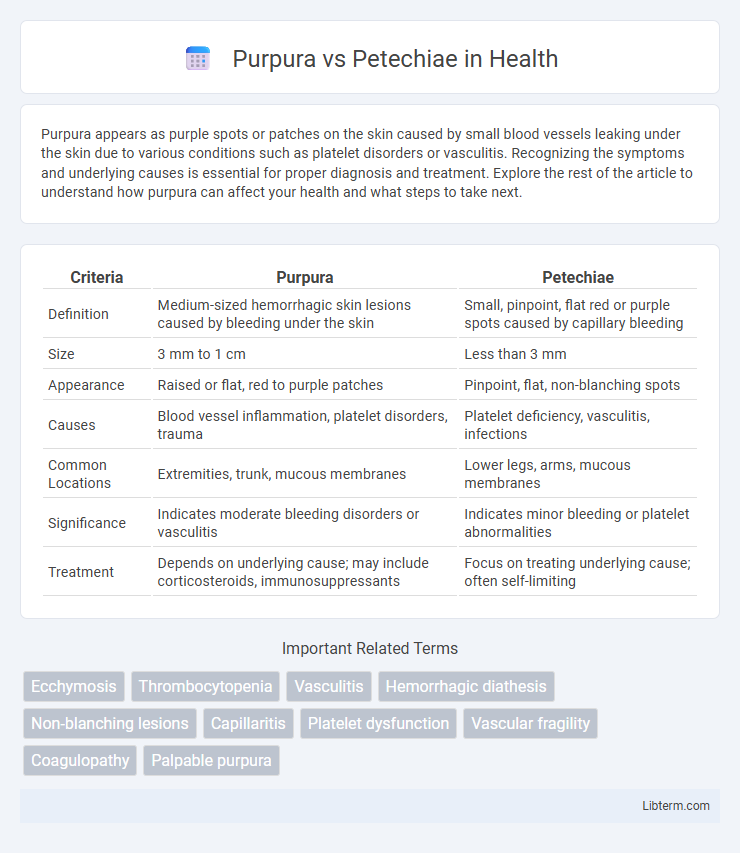Purpura appears as purple spots or patches on the skin caused by small blood vessels leaking under the skin due to various conditions such as platelet disorders or vasculitis. Recognizing the symptoms and underlying causes is essential for proper diagnosis and treatment. Explore the rest of the article to understand how purpura can affect your health and what steps to take next.
Table of Comparison
| Criteria | Purpura | Petechiae |
|---|---|---|
| Definition | Medium-sized hemorrhagic skin lesions caused by bleeding under the skin | Small, pinpoint, flat red or purple spots caused by capillary bleeding |
| Size | 3 mm to 1 cm | Less than 3 mm |
| Appearance | Raised or flat, red to purple patches | Pinpoint, flat, non-blanching spots |
| Causes | Blood vessel inflammation, platelet disorders, trauma | Platelet deficiency, vasculitis, infections |
| Common Locations | Extremities, trunk, mucous membranes | Lower legs, arms, mucous membranes |
| Significance | Indicates moderate bleeding disorders or vasculitis | Indicates minor bleeding or platelet abnormalities |
| Treatment | Depends on underlying cause; may include corticosteroids, immunosuppressants | Focus on treating underlying cause; often self-limiting |
Understanding Purpura and Petechiae
Purpura and petechiae are both skin manifestations caused by bleeding underneath the skin, differing mainly in size; purpura lesions are larger than 3 millimeters, whereas petechiae measure less than 3 millimeters. These conditions commonly indicate underlying vascular or platelet disorders, such as thrombocytopenia, vasculitis, or coagulation abnormalities, requiring clinical evaluation for accurate diagnosis. Understanding the distinct appearance and clinical implications of purpura and petechiae helps healthcare providers identify potential systemic diseases and initiate appropriate treatment.
Definitions: What are Purpura and Petechiae?
Purpura are red or purple discolorations on the skin caused by bleeding underneath, typically measuring between 3 mm and 10 mm in diameter, indicating blood vessel leakage or platelet abnormalities. Petechiae are smaller, pinpoint-sized hemorrhages less than 3 mm in diameter, often signaling capillary bleeding or platelet dysfunction. Both conditions reflect underlying vascular or hematologic issues but differ mainly in size and clinical significance.
Key Differences Between Purpura and Petechiae
Purpura and petechiae are both types of bleeding into the skin, but purpura are larger, typically measuring 3 to 10 millimeters, while petechiae are smaller, less than 3 millimeters in diameter. Purpura often indicate a more severe underlying condition such as vascular inflammation or platelet dysfunction, whereas petechiae usually result from minor capillary hemorrhages or platelet abnormalities. The distinct size and clinical implications help differentiate purpura from petechiae during diagnosis and treatment planning.
Causes of Purpura
Purpura is caused by factors such as platelet abnormalities, vascular disorders, and coagulation defects leading to blood leakage into the skin, whereas petechiae result from minor capillary bleeding typically linked to infections or physical trauma. Common causes of purpura include thrombocytopenia, vasculitis, scurvy, and certain medications that increase bleeding risk. Understanding the underlying etiology of purpura is crucial for targeted treatment and differentiating it from petechiae, which are usually smaller and less associated with systemic disease.
Causes of Petechiae
Petechiae are small, pinpoint, red or purple spots caused by bleeding under the skin, often resulting from platelet abnormalities, vascular disorders, or physical trauma. Common causes include thrombocytopenia, vitamin K deficiency, infections like meningococcemia, and conditions that increase capillary fragility such as vasculitis. Unlike purpura, which are larger spots usually caused by a broader range of bleeding or vascular issues, petechiae specifically indicate microvascular bleeding often linked to platelet or coagulation defects.
Clinical Presentation and Appearance
Purpura and petechiae both present as red or purple skin lesions caused by bleeding underneath the skin, but purpura lesions are larger, typically measuring 3-10 mm, while petechiae are smaller, less than 3 mm in diameter. In clinical presentation, purpura often appear as flat, non-blanching patches or bruises that may indicate vasculitis, thrombocytopenia, or coagulation disorders. Petechiae manifest as pinpoint, flat red or purple spots commonly found on the lower extremities and can signal platelet abnormalities or infections such as meningococcemia.
Diagnostic Approaches
Purpura and petechiae are diagnosed primarily through detailed clinical examination and patient history, emphasizing lesion size and distribution; purpura lesions typically exceed 3 mm, while petechiae are pinpoint spots under 3 mm. Laboratory tests such as complete blood count (CBC), coagulation profiles, and platelet function assays help identify underlying causes like thrombocytopenia or vascular disorders. Skin biopsy may be performed to differentiate between vasculitis and other pathologies contributing to purpura or petechiae.
Associated Medical Conditions
Purpura and petechiae are both skin manifestations resulting from bleeding under the skin, with purpura typically larger than 3 mm and petechiae less than 3 mm in diameter. Purpura often indicate underlying conditions such as vasculitis, thrombocytopenia, or coagulation disorders like disseminated intravascular coagulation (DIC), while petechiae are commonly associated with platelet abnormalities, infections like meningococcemia, or physical trauma. Recognizing these differences aids in diagnosing serious medical conditions including immune thrombocytopenic purpura (ITP) and sepsis.
Treatment Options for Purpura and Petechiae
Treatment options for purpura primarily depend on the underlying cause, with corticosteroids and immunosuppressants commonly used for immune-related cases, while addressing infections or medication side effects is critical. Petechiae treatment focuses on managing the root cause such as platelet disorders or infections, often involving platelet transfusions or antibiotics, and supportive care may include rest and avoiding trauma. Both conditions require prompt medical evaluation to prevent complications and tailor therapy based on diagnostic findings like platelet counts and coagulation profiles.
When to Seek Medical Attention
Seek medical attention immediately if purpura or petechiae appear suddenly, spread rapidly, or are accompanied by symptoms such as fever, unexplained bruising, bleeding, or weakness, as these may indicate serious conditions like blood clotting disorders or infections. Persistent or recurrent purpura and petechiae warrant evaluation by a healthcare professional to rule out underlying causes such as vasculitis, platelet abnormalities, or hematologic diseases. Prompt diagnosis and treatment can prevent complications and improve patient outcomes.
Purpura Infographic

 libterm.com
libterm.com